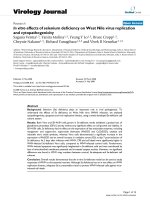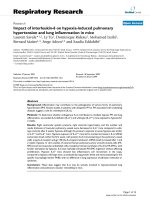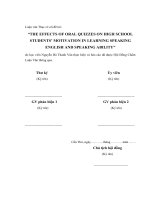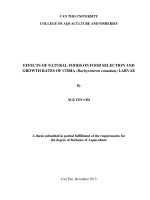The effects of chloride ions on the hydrogen gas generation and TCE degradation in aqueous solutions containing zero valent iron
Bạn đang xem bản rút gọn của tài liệu. Xem và tải ngay bản đầy đủ của tài liệu tại đây (686.81 KB, 57 trang )
THE EFFECTS OF CHLORIDE IONS ON THE HYDROGEN GAS
GENERATION AND TCE DEGRADATION IN AQUEOUS
SOLUTIONS CONTAINING ZERO VALENT IRON
Thesis for the Degree of Master of Science in Engineering
Khanh An Huynh
2007
Department of Civil and Environmental Engineering
Korea University
Thesis for the Degree of
Master of Science in Engineering
The Effects of Chloride Ions on the Hydrogen Gas
Generation and TCE Degradation in Aqueous
Solutions Containing Zero Valent Iron
By Huynh, Khanh An
Department of Civil and Environmental Engineering
The Graduate School of
Korea University
December 2007
金 之 瀅 敎授指導
博士學位論文
The Effects of Chloride Ions on the Hydrogen Gas
Generation and TCE Degradation in Aqueous
Solutions Containing Zero Valent Iron
이 論文을 工學 博士學位 論文으로 提出함.
2007 年 12 月
高麗大學校 大學院
社會環境시스템工學科
Huynh, Khanh An
The Effects of Chloride Ions on the Hydrogen Gas Generation and
TCE Degradation in Aqueous Solutions Containing Zero Valent
Iron
Huynh, Khanh An
Dept. of Civil and Environmental Engineering, Graduate school of Korea University
Abstract
The effects of chloride ions on the hydrogen gas generation and trichloroethylene
(TCE) degradation in aqueous solutions containing zero valent iron were
investigated in this study. TCE degradation rate followed pseudo-first order kinetic
with respect to TCE concentration. Chloride ions had strong effects on TCE
degradation rates at low pH. They were 32.93%, 19.51%, 7.54% higher at pH of
4.84, 6.41 and 7.16, respectively, in the presence of 20mM NaCl. The degradation
of TCE depended on the chloride concentrations. The increase of chloride
concentrations increased TCE degradation rates until the concentration of 40 mM
NaCl was reached. Degradation rate constant increased to 7.80E-05 h-1m-2L which
was 40% higher than using iron only. Further increase in chloride concentrations
resulted in the decrease of degradation rate constants. The hydrogen gas generation
of iron in the anaerobic aqueous solutions was also determined. It depended on
solution pH, the presence of electron receiving competitor such as TCE, the amount
of iron corrosion promoter such as NaCl. In the solutions containing chloride ions,
TCE, the generation rate of hydrogen gas could be characterized as Riron corrosion >
Riron+TCE+Cl > Riron+TCE.
i
CONTENTS
Abstract ........................................................................................................................................ i
CONTENTS ................................................................................................................................ ii
LIST OF FIGURES ................................................................................................................... iv
LIST OF TABLE ...........................................................................................................................
1.
INTRODUCTION ..............................................................................................................1
2.
LITERATURE REVIEW ..................................................................................................5
2.1.
Dechlorination reaction by Zero valent iron (ZVI)...........................................................5
2.1.1.
Mechanism ...................................................................................................................5
2.1.2.
Kinetic ..........................................................................................................................9
2.2.
Effects of chloride ions on dechlorination reaction ........................................................10
2.2.1.
Effect of chloride ions on iron corrosion....................................................................10
2.2.2.
Effect of chloride ions on degradation of halogenated compounds ...........................13
2.3.
Hydrogen gas generation from dechlorination reactions ................................................14
2.3.1.
Hydrogen gas generation from iron corrosion and dechlorination reactions..............14
2.3.2.
The possibility of the combination between TCE dechlorination and biotic
denitrification by ZVI....................................................................................................15
3.
MATERIALS AND METHODS .....................................................................................18
3.1.
Iron Powders...................................................................................................................18
3.2.
Experimental apparatus ..................................................................................................18
3.2.1.
Estimation of hydrogen gas generation ......................................................................18
3.2.2.
The effect of chloride ions on TCE degradation by ZVI ............................................21
ii
4.
RESULTS AND DISCUSSIONS .....................................................................................25
4.1.
Estimation of hydrogen gas generation ..........................................................................25
4.1.1.
Hydrogen gas generation from iron corrosion............................................................25
4.1.2.
Hydrogen gas generation in the presence of TCE ......................................................26
4.1.3.
Hydrogen gas generation in the presence of TCE and chloride ions. .........................28
4.1.4.
Conclusion about the hydrogen gas generation ..........................................................29
4.2.
Effects of chloride ions on TCE degradation by ZVI .....................................................31
4.2.1.
The effect of pH on TCE degradation ........................................................................31
4.2.2.
The effects of chloride concentrations on TCE degradation ......................................38
4.2.3.
Conclusion about the effect of chloride on TCE degradation. ...................................40
5.
CONCLUSIONS ...............................................................................................................42
REFERENCES ..........................................................................................................................44
iii
LIST OF FIGURES
Figure 1. Reaction pathways for TCE reduction by Fe0 proposed by Arnold and
Roberts (2000) ...........................................................................................................7
Figure 2. Proposed hydrogenolysis of TCE in anoxic Fe0-H2O system (Matheson
and Tratnyek, 1994). ..................................................................................................8
Figure 3. Concept of Fe(0)-supported denitrification (Till et al., 1998) .................16
Figure 4. Experiments for the investigation of hydrogen gas generation ...............20
Figure 5. Experimental procedure for determining effect of pH on TCE degradation
by ZVI in the presence of chloride ions. ..................................................................22
Figure 6. Experimental procedure for determining effect of pH on TCE degradation
by ZVI in the presence of chloride ions ...................................................................23
Figure 7. Hydrogen gas generation from iron corrosion .........................................25
Figure 8. Hydrogen gas generation from iron corrosion in the presence of TCE ..27
Figure 9. Hydrogen gas generation in the presence of TCE and chloride ions. ......28
Figure 10. Hydrogen gas generation at pH 4.8 .......................................................30
Figure 11. Hydrogen gas generation at pH 6.4 .......................................................31
Figure 12. TCE degradation by ZVI at pH 4.84 in the presence of chloride ions..32
Figure 13. TCE degradation by ZVI at pH 6.41 in the presence of chloride ions...32
Figure 14. TCE degradation by ZVI at pH 7.14 in the presence of chloride ions...33
Figure 15. (a) Surface area normalized degradation rate constant of TCE at
different pH; (b) The increase of TCE degradation rate in the solution containing Fe
and 20 mM NaCl. .....................................................................................................34
iv
Figure 16. Hydrogen gas generation from iron corrosion at pH 4.8 .......................36
Figure 17. Hydrogen gas generation from iron corrosion at pH 6.4 .......................37
Figure 18. Observed rate constant of degradation reactions at different NaCl
concentrations ..........................................................................................................39
v
LIST OF TABLES
Table 1. Properties of iron samples ............................................................................... 18
Table 2. The surface area normalized reaction rate constant at different chloride
concentrations ................................................................................................................ 40
1. INTRODUCTION
The use of halogenated compounds in industry has led the groundwater to be
polluted. These compounds such as Trichloroethylene (TCE), Perchloroethylene
(PCE) are generally toxic to human health and can cause some serious diseases
(ATSDR, 2006). The study on degradation of halogenated organic compounds by
zero valent metals has been carried out extensively recently. Among zero valent
metals, iron is the most popular metal used for the dechlorination because of its
availability, low cost, and low toxicity to the environment. Zero valent iron (ZVI)
reactive barriers have been shown to be a cost-effective alternative to conventional
pump-and-treat technologies for in situ remediation of groundwater contaminated
with chlorinated hydrocarbons.
Dechlorination of TCE by ZVI is a reductive reaction in which TCE receives
electrons released from the iron surface to produce compounds with lesser chlorine
such as ethane, ethylene, cis and trans Dichloroethylene (DCE), etc (Arnold and
Robert, 2000).
The degradation of TCE by ZVI is a surface based reaction with three major steps:
(a) adsorption of TCE to the iron surface, (b) reaction at the surface and (c)
desorption of the products. The rate of the degradation depends mainly on the
active surface area of iron, solution pH, the mixing rate, temperature, the
competitions of other electron acceptors (water, reaction products, etc), the
presence of corrosion promoters or inhibitors, etc.
pH is the most important factor that affects the degradation of TCE. The study of
Chen et. al. (2001) showed that the increase of pH resulted in lower surface
normalized reaction rate constant of TCE degradation and iron corrosion. In
addition, pH also involves the precipitation of iron hydroxides on the iron surface
due to the reduction of water. Long term observation showed that the higher pH, the
1
smaller active areas on the iron surface are available for releasing and transferring
electrons to TCE. The degradation process will decrease, consequently (Orth and
Gillham, 1996).
Chloride salts are well-known as corrosion promoters. Their main effect on iron
corrosion is the production of pits containing acidic microenvironments on the iron
surface, which can stimulate metal dissolution. However, the acceleration in iron
corrosion by chloride ions occurs just in a certain range of concentrations. Chloride
ions decreased the corrosion of iron in the study carried out by Reardon (1995),
which showed that the corrosion rate of iron appeared lower for the saline
groundwater compared to de-ionized water. They also decreased with the
increasing NaCl concentration. According to Podobaev (2005) and Aleksanyan et
al. (2007), chloride ions can promote or inhibit iron dissolution depending on their
concentrations and the pH value of solution.
Previous studies reported that the degradation of halogenated compounds can be
improved in the presence of chloride. The complete degradation of TNT by ZVI in
the presence of 5mM NaCl was in 90 minutes. When ZVI was used alone, only
40 % of TNT was degraded after 120 minutes of reaction (Kim et al., 2007). On the
other hand, Johnson et al. (1998) investigated the effects of chloride ions on the
degradation of CCl4 without pH control. In this study, CCl4 removal rate was
maximum with the concentration of NaCl about 0.06 mM and became lower when
the NaCl conentration was increased.
Hydrogen gas is a product of iron corrosion in anaerobic aqeous solution. Water
receives electrons from iron and relases H2, together with OH-. Hydrogen gas
evolution is important in developing permeable reactive barrier (PRB) remediation
technology. If the rate of hydrogen gas production exceeds the rate of its removal in
the dissolved state, a two phase flow could develop. The consequence could be the
2
restriction or short-circuiting of the ground water through the PRB. On the positive
side, the produced hydrogen gas is a potential fuel source for various
microorganisms, whose biochemical activity can potentially carry out other organic
degradation reactions at contaminated sites (Reardon, 2005).
De-nitrification in groundwater by autotrophic bacteria using hydrogen gas from
anaerobic corrosion of iron as electron donors was carried out by some researchers
(Till et al., 1998; Biswas and Bose, 2005). The results demonstrated that 0.5g of
steel wood and hydrogenotrophic denitrifying microorganisms were sufficient to
reduce nitrate concentrations from 40mg/L (as NO3--N) to less than 2mg/L (as NO3-N) with a retention time of 13 days (Biswas and Bose, 2005).
TCE and water are competitors for receiving electrons from iron. As a result, the
hydrogen gas generation rate in the solution containing TCE may be lower than that
in the case of iron corrosion only. However, it is possible to combine dechlorination
and denitrification processes in one treatment process using ZVI. For the
occurrence of biotic denitrification using hydrogen gas as an electron donor,
hydrogen gas should be supplied adequately to the microorganisms. Thus, the rate
of hydrogen gas generation is a significant parameter in this reaction.
Researches showed that elevated concentration of chloride ions (Cl-) in the surface
and ground water were common in the United States and other countries (Panno et
al., 2006). Approximately 14% of 244 Texas counties had median chloride
concentration exceeding 250 mg/L. Several counties had very high median of
chloride levels, above 500 mg/L. Factors contributing to high chloride levels can
include mineral constituents of the aquifers, seepage of saline water from nearby
formations, coastal salt water intrusion, irrigation return flow, and oil/gas
production (Hudak, 2000). Therefore, the study about the effect of chloride on
3
TCE degradation by zero valent iron is important in designing the remediation
facility for groundwater treatment at the site containing high chloride level.
However, this topic has not received sufficient coverage in the literature to date.
Based on the aforementioned facts, it is important to evaluate the effects of chloride
ions on TCE degradation by ZVI as well as the generation of hydrogen gas from
that reaction. These issues are the main objectives for this research. The following
experiments were performed to assist the study:
Estimating the generation rate of hydrogen gas from
+ Iron corrosion reaction,
+ TCE degradation reaction by ZVI,
+ TCE degradation reaction by ZVI in the presence of chloride ions.
Investigating the effects of chloride ions on TCE degradation by ZVI
+ The effect of pH on TCE degradation in the presence of chloride ions.
+ The effect of chloride concentrations on TCE degradation
The study is based on the hypothesis that chloride ions can enhance the degradation
of TCE by ZVI due to the increase in iron corrosion.
4
2.
LITERATURE REVIEW
This chapter gives brief definitions, mechanisms and kinetics of dechlorination
reaction. In addition, the effects of chloride ions on the corrosion of iron and
chlorinated compounds are introduced as well. This chapter also describes the
generation of hydrogen gas from dechlorination reaction and the possibility for the
combination of TCE degradation and denitrification in one process using zero
valent iron.
2.1.
Dechlorination reaction by Zero valent iron (ZVI)
The study about dechlorination reaction of TCE by zero valent iron was performed
extensively during last decade. It is confirmed that the use of zero valent is
effective in in-situ remediation of groundwater contaminated with chlorinated
hydrocarbons, nitrate or chromate.
2.1.1. Mechanism
Reduction of halogenated organic compounds by ZVI is an an-biotic,
heterogeneous, and electrochemical reaction in which iron is oxidized and
halogenated compounds are reduced.
The corrosion of iron in the aqueous phase releases electrons to the solution, which
is shown in the following half reactions (1 and 2)
Fe2+ + 2e-
→
Fe0
(1)
E0 = -0.44 V
Fe3+ + e-
→
Fe2+
(2)
E0 = 0.77 V
5
In the absence of oxygen, chlorinated aliphatic hydrocarbons and water are in
competition to receive the electrons released from the iron surface.
2H2O + 2eTCE + (xH+) + ye-
→
H2 + 2OH(3)
→
E0=-0.379 V
product + (y-x)Cl(4)
E0=0.37-0.63 V
From the value of E0 in above equations, it can be concluded that dechlorination
reactions are thermodynamically favorable. The produced hydroxide ions (OH-)
from the reaction (3) result in increasing pH in weakly buffered system. The
precipitates iron hydroxide can be on the metal surface and prevent the dissolution
of iron (Matheson and Tratnyek, 1994).
Recent studies showed that -reductive elimination (in which two halide ions are
released), hydrogenolysis (replacement of a halogen by a hydrogen atom) and
hydrogenation (the addition of hydrogen to unsaturated compounds) are the main
mechanisms for dechlorination reaction (Matheson and Tratnyek, 1994; Arnold and
Roberts, 2000) as shown in the flowing reactions, respectively.
RHCl = RHCl + 2e- + H+
RH2=RHCl + Cl(5)
+ 2Cl-
RHCl = RHCl + 2e-
(6)
Arnold and Roberts (2000) indicated that reductive -elimination accounts for a
97% TCE degradation. A 100% degradation of highly reactive chloro- and
dichloro- acetylene mediates produced from reductive elimination of TCE occurs
via hydrogenolysis.
6
Observed products of the dechlorination reactions are ethylene, acetylene, cis-,
trans- DCE. Trace amounts of longer chain hydrocarbons (C3, C5, C6) were also
detected (Arnold and Roberts, 2000).
Cl
Cl
C
C
Cl
H
TCE
H
Cl
C
C
H
chloroacetylene
Cl
Cl
C
Cl
C
C
H
Cl
H
trans-DCE
C
C
H
H
C
C
Cl
H
1,1-DCE
C
H
C
C
H
C
acetylene
H
C
cis-DCE
Cl
H
Cl
C
H
Vinyl chloride
H
H
C
C
C
H
H
ethene
C4-molecules
H
H
H
C
C
H
H
H
ethane
Figure 1. Reaction pathways for TCE reduction by Fe0 proposed by Arnold and Roberts
(2000)
7
Fe3+
RCl + H+
Fe2+
RCl + H+
Fe2+
e-
RH + Cl-
H 2O
-
e
OH- + H2
RH + Cl-
(a)
(b)
Fe + RCl + H → Fe + RH + Cl
0
+
2+
2Fe + RCl+ H → 2Fe3+ + RH + Cl-
-
2+
+
Fe2+
H 2O
e-
RCl + H+
OH- + H2
RH + Cl- + H+
catalyst
(c)
H2 + RX → RH + H+ + XFigure 2. Proposed hydrogenolysis of TCE in anoxic Fe0-H2O system (Matheson and
Tratnyek, 1994). (a) Direct electron transfer from iron metal at the iron surface. (b)
Reduction of Fe2+, which results from iron corrosion. (c) Catalyzed hydrogenolysis by the
H2 from anaerobic corrosion
8
2.1.2. Kinetic
The dechlorination reaction by Fe0 is a surface based reaction in which close
contact of reactive media and contaminants is required for the electron transfer to
occur. Therefore, the rate of dechlorination is mainly depended upon the rate of
mass transfer of contaminant between the bulk solution and the Fe0 surface via
stagnant fluid layer surrounding Fe0 and the rate of electron transfer from Fe0 to the
contaminants (Lai and Lo, 2007)
The reaction kinetics was studied extensively. Although there are many degradation
pathways and various processes occurring at the iron surface, such as adsorption of
the TCE, chemical reaction at the surface, desorption of the products, most of the
studies showed that the reaction was generally a second order reaction with respect
to the concentration of substrate (TCE) and concentration of specific environmental
reactant (iron) as described by the equation below (Tratnyek et al., 1997)
d [ P]
kSA a [ P]
dt
(7)
In this equation, kSA is the specific rate constant (L hr-1 m-2), a is the concentration
of iron surface area (m2 L-1 of solution) and P is the concentration of TCE. By using
surface area normalized rate constants, it is possible to make generalizations about
degradation rates by iron metals that apply over a wide range of laboratory
conditions (Tratnyek et al., 1997)
When the amount of iron in the solution is abundant, we can assume that a does
not decrease during the reaction. In this case, the reaction can be called a pseudofirst order reaction with respect to TCE concentration.
9
d [ P]
kobs [ P]
dt
(8)
With kobs = kSA. a, which is called a pseudo-first order rate constant.
The kinetic model represented by equations 7 and 8 is formulated to reflect only a
single pathway of contaminant transformations. However, it now appears that the
degradation of hydrocarbons by iron metal can be due to a variety of degradation
pathways. The various possibilities can be accommodated by expanding k SA into
the sum of rate constants for each individual degradation pathway. Thus, we can
write,
kSA = ket + kre + kother,
Where ket represents hydrogenolysis, kre represents reductive elimination and kother
is included to accommodate other possibilities whose importance remains to be
demonstrated (Tratnyek et al., 1997)
2.2.
Effects of chloride ions on dechlorination reaction
2.2.1. Effect of chloride ions on iron corrosion
Corrosion is an electrochemical process involving the transfer of electrons between
a metal surface and an electrolyte solution. It results from the reaction of metals
with oxygen, water and other substances in an aqueous environmental or humid air.
This process creates an electro-chemical cell in which metal serves as the anode
(electron donor) and oxygen as the cathode (electron acceptor) with the solution of
ions serving as a salt bridge. Dissolution of the metal occurs at anodic sites,
releasing ions which may then react to form insoluble corrosion products (rust).
10
The thin film of hydroxides that develops on ZVI evolves into a complex layer
structure as a result of oxidation, re-crystallization, and precipitation.
Chlorides penetrate pores or defects in the oxide film more readily than other ions
and can disperse the oxidation film, increasing permeability. The halide ion also
adsorbs on the film in competition with dissolve oxygen or OH -. This process
favors hydration of the metal ions and increases the ease with which the ions enter
solution, in contrast to adsorbed oxygen, which decrease the rate of metal
dissolution.
From an electrochemical perspective, the absorbed chloride increases the exchange
current (decreases overvoltage) for anodic dissolution from that of surfaces covered
with oxygen. Thus the iron is not readily passive in solution containing appreciate
Cl- and the metal continues to dissolve at high rate.
The corrosion rate increases with the salt concentration, reaching a maximum at
approximately 3% NaCl (average salt content of sea water), then decreases, falling
below that of distilled water when the saturation is reached (26 % NaCl). The
decrease at very high salt concentration occurs because the solubility of oxygen in
water decreases with increasing salt concentration.
Breakdown of passivity with chloride occurs locally, with sites determined by
variations in the oxide film structure and thickness. Pitting corrosion is a form of
localized corrosion that does not spread laterally across an exposed surface but
penetrates into the metal.
11
Pit initiation occurs when an electrochemical or chemical reaction exposes a local
site on a metal surface to aggressive halide ions. Precipitates of metal ions usually
cover the pit area, causing a buildup of protons (and thus positive charge) with the
pit. The electrical charge imbalanced between the high positive charge within the
pit and the negative charge outside causes negative halide ions to diffuse into the pit
to maintain charge neutrality. The halide ions migrate to anodic sites and metal ions
hydrolyze, producing HCl which inhibits the formation of a
passive
oxide/hydroxide film. Instead of reacting only with hydroxyl ions, the iron reacts
with halide ions. Iron is very soluble in the chloride form. Anions that form solute
complexes tend to extend the zone of corrosion while those that form insoluble
compounds tend to extend the zone of passivity. The HCl reacts with the metal to
produce ferrous chloride and hydrogen gas, or ferric chloride and water. Hydrolysis
of the metal chloride forms Fe(OH)2 (which is not passive) and H+ causing pH to
fall about 3 and facilitating further anodic dissolution. The gradual increase in
metal ion concentration stimulates further migration of chloride and the process
becomes autocatalytic. While anodes and cathodes must be relatively near each
other in distilled water, they can be much further apart in salt solution because of
greater conductivity. Passivity is decreased because the oxide will tend to form
away from the metal surface.
Generally, chloride ions can increase or decrease the corrosion rate of iron
denpeding on their concentrations, and the solution pH. According to Podobaev
(2005) and Aleksanyan et al. (2007), chloride ions can promote or inhibit iron
dissolution depending on their concentrations and the pH value of solution.
In a study about the measurement of hydrogen gas generation in anaerobic
corrosion, Reardon (1995) found that corrosion rates decrease with increasing NaCl
concentration from 0.02 to 3.0 M.
12
2.2.2. Effect of chloride ions on degradation of halogenated compounds
Previous studies presented that the degradation of halogenated compounds can be
improved in the presence of chloride ions.
Hernandez et al. (2004) reported that addition of chloride accelerated TNT
degradation during treatment of contaminated water with ZVI.
The presence of 1% w/v chloride salts remarkably increased the degradation rate of
high explosives in aqueous solution such as TNT, RDX and HMX (Kim et al.,
2007). The complete degradation of TNT in the company of 5mM NaCl was in 90
min and only 40 % of TNT was degraded after 120min with zero valent alone.
Furthermore, the degradation rate was faster with 50 mM of NaCl. The study also
indicated that presence of Cl- maintained a highly reactive iron surface and
sustained a high rate of destruction for a much longer period than ZVI alone.
On the other hand, NaCl was seemed to decrease the corrosion rate of iron in the
study carried out by Reardon (1995) which showed that the corrosion rate of iron
appeared lower for the saline groundwater compared to de-ionized water. And the
corrosion rates decreased with the increasing NaCl concentration. Johnson et al.
(1998) investigated the effects of chloride ions on the degradation of CCl 4 without
pH control. In this study, CCl4 removal rate was maximum with the concentration
of NaCl about 0.06 mM and became lower when the NaCl conentration was
increased. However, the pH measurement was not performed.
13
2.3.
Hydrogen gas generation from dechlorination reactions
2.3.1. Hydrogen gas generation from iron corrosion and dechlorination
reactions.
Even in the absence of oxygen, iron still corrodes by the oxidative action of water
itself as shown in half reaction 1 and 3.
Fe(s) + 2H2O(l)
→
Fe2+ + 2OH- + H2(g)
(9)
In this reaction, iron is a reductant (electron donor) and water is an oxidant
(electron acceptor). And one mol of hydrogen gas generated for every mole of iron
corroded. As a result, hydrogen gas generation is directly related to iron corrosion.
Hydrogen gas evolution is considerable important in developing PRB remediation
technology. If the rate of hydrogen gas production exceeds the rate of its removal in
the dissolved state, a two phase flow could develop. The consequence could be the
restriction or short-circuiting of the ground water through the PRB. On the plus side,
the produced hydrogen gas is a potential fuel source for various microorganisms,
whose biochemical activity can potentially carry out other organic degradation
reactions at contaminated sites. Bacterial utilization of hydrogen, however, can lead
to bio-film formation in the pore network. This can lead to decrease in porosity and
permeability within the PRB (Reardon, 2005).
There are two kinds of approach when consider hydrogen gas generation by ZVI.
They are from electro-chemical standing point and environmental standing point.
Electro-chemical standing point: estimates the hydrogen gas evolution by
measuring some electro-chemical parameters such as Tafel analysis,
electrochemical impedance spectroscopy (Wang and Farrell, 2003)
14
Environmental standing point: due to the complex understanding and
measurement equipment of electrochemical, the hydrogen gas generation in the
reactor can be measured by the change of pressure inside the reactor due to
hydrogen gas built up.
Two of these methods both have advantages and disadvantages. It’s will be better
when combine two methods together. Due to the lack of equipment as well as
deeply understanding about other fields, environmental standing point is preferred.
However, the researchers from electro-chemical standing point are good references
for discussing and explaining the results from the studies.
2.3.2. The possibility of the combination between TCE dechlorination
and biotic denitrification by ZVI
Reduction of nitrate by ZVI is a highly exergonic reaction and has long been known
to occur. Previous studies demonstrated that nitrate can be completely reduced by
metallic iron under anoxic and aerobic conditions, with the major product being
ammonia.
4Fe(0) + NO3- + 7H2O
→
4Fe2+ + NH4+ + 10OH-
(10)
However, ammonia has an adverse aesthetic impact on drinking water and may
interfere with subsequent disinfection process.
De-nitrification in groundwater by autotrophic bacteria using hydrogen gas from
anaerobic corrosion of iron as electron donors was carried out by some researchers
(Till et al., 1998; Biswas and Bose, 2005). The results demonstrated that 0.5g of
steel wood and hydrogenotrophic denitrifying microorganisms were sufficient to
15









